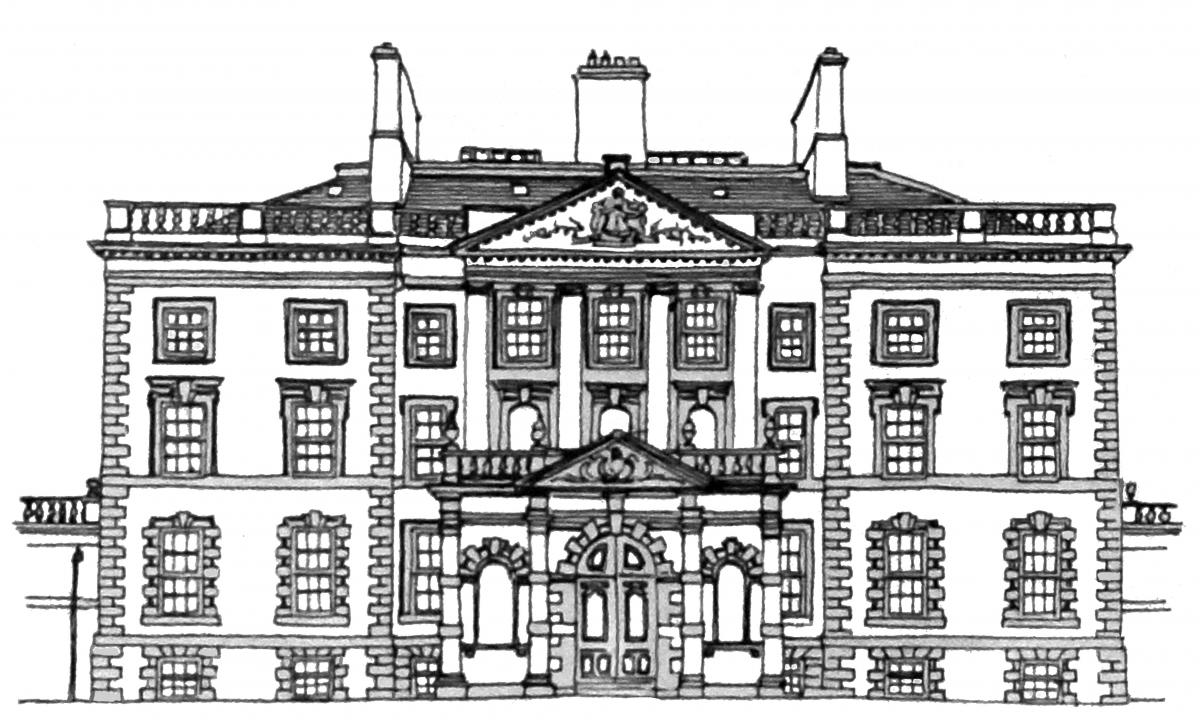By Althea Dundas-Bekker
“My inheriting of Arniston, when I was thirty, in 1970 was bitter sweet. Bitter because it involved the premature deaths of close members of my family. Sweet because of what Arniston is. It has been described as one of the most important William Adam houses in Scotland. Surprisingly, only 11 miles from Edinburgh, visitors and guests frequently remark on the ethos of peace and timelessness both in the outside policies (parkland) and in the interior of the house.
As a family we love to tell the 450 year history of the Dundases and our home. Guided tours, regularly and mostly by family members, have taken place for nearly fifty years. As part of a natural progression, we have recently developed a range of event services, both outside the house and sensitively within.
But recently a large part of Arniston’s legacy has been the long period of restoration due to the discovery of extensive dry rot in the 1950s. On my arrival an architectural report was commissioned on the whole of the house and we were shaken to hear the results. A six phase restoration plan would be required and at the time this seemed unachievable.
There were first extensive death duties to be paid off. But the saving of such an important part of Scotland’s built heritage has been achieved with great love and the support of the people who care so much about it. Onward it travels 900 hundred years on from its record as the hunting ground of King David of Scotland who granted it to the Knights Templar.”

Read More
George Dundas, 16th Laird of Dundas Castle, South Queensferry, and his wife Katherine Oliphant, bought the land in 1571. It was for a younger son, James, and their choice was good especially for the setting. There were few trees then so the potential for views from a future house was stunning. The sight extended right over the Firth of Forth to the Kingdom of Fife and the Lomond Hills. To the North West was Arthur Seat, the Salisbury Crags and Edinburgh Castle. To the West the Pentland Hills and due south the Moorfoot Hills. A mile away was the historic village of Temple, headquarters in Scotland, from the 1100s to the 1300s, of the Knights Templar. Two hundred years on in the late 1700s this scene is again re-enforced in a landscape painting by the Scottish artist, Alexander Nasmyth. It hangs now in the Arniston dining room and looks out to exactly the scene it portrays. It is stunning portraying the same view albeit with the addition of many fine trees.
The Arniston situation must have greatly fired up the celebrated Scottish Architect William Adam when he was asked in 1724 to draw up plans for a Mansion house to replace the former 1500sTower House. Adam was at the height of his career and had talented sons, famous Robert, and also John, James, and William. Stones from the Tower House, long since incorporated into ornamental structures outside, suggest it would have been a very fine house. One wonders therefore if it is sad the Tower House was replaced. The Oak Room, from the Tower House, was retained in the present house, and many, including myself, declare it is their favourite room. But who so bold as to grudge a William Adam house, particularly as it has been described as “one of the most important Georgian country houses in Scotland”. Why did the family do it? Like Adam, the Dundases at that time were rising in their legal careers which would eventually boast Solicitor’s General, Lord Advocates and even Presidents of the Court of Session. So the parliamentary union of the early 1700s required them to venture, more than they had ever done before, south of the border to attend the Westminster parliament. And this was a family who had fought and some died fighting determinedly in the 1300s for Scotland’s independence. Dundas was homesick down there. Scots were not particularly welcome. They were considered coarse and barbaric; the Malt Tax had been introduced and was very detrimental to Scotland’s interests. This was too much for Dundas who vociferously spoke out against it and was immediately sacked for insubordination. But he had, during his short time down there, noted the impressive classical buildings. In 1725 William Adam’s plans were given the go ahead.
Adam was quick to take up the country theme in the new hall which took the place of the former Tower House open courtyard. The intricate stucco work took seven years and tells us we are indeed in the country with flowers, fruit, birds, etc. Even the symbolism features nature such as swags of peaches which wish the family long life as peach trees can survive for many years. Different styles of architecture satisfy the discerning eye. The house progressed well but in 1732 came a bitter blow. The money ran out. Work came to an abrupt halt. The Dundases so rich in legal wisdom were paradoxically not blessed with financial acumen. For William Adam his project was so tantalisingly nearly complete. Just the west third of the main block and plans for his first floor Staterooms and processional route for viewing the stucco work to be completed, but tragically for him, this would never be done. Twenty years on when funding came to hand, changing fashions persuaded the new architect, John Adam, not to do his late father’s wishes. Instead he used the space for two ground floor public rooms with high coved ceilings giving spectacular west light. Now one is the Dining Room with the Nasmyth and also Scottish portraiture including paintings by Alan Ramsay. The drawing room next to it has Chinese decorative wall paper much admired which has even attracted complimentary articles by well-known publications.
Then in the 1950s another blow. The Adam family were spared, they were long since gone, but for the Dundas family, and for followers of Adam and the many who love Arniston, it was terrible. Dry rot so extensive Arniston might have to be abandoned. Thus Scotland could lose an important part of its history, its designed landscape, the outstanding collections of historic artefacts documenting the family history and the history of Scotland covering four centuries, would have to be dispersed. The Archives as early as the 1800s had told of spasmodic dry rot outbreaks but in 1957 it was discovered the John Adam side of the house would have to be dismantled.
Funds then did not allow for re-instatement. This became my problem on my arrival in 1970. I had since childhood a passion for Scottish History and having worked for the National Trust for Scotland for four years in the 60s had developed a deep appreciation of the importance of Scotland’s Built Heritage. On arrival I had understood the John Adam dismantlement was the end of the problem though there were heavy death duties to be paid off before restoration could be contemplated. But my friends in the NTS had deep concerns. “Althea”, they said “we can smell further dry rot”. They urged me to have an architectural report done on the whole of the house, they were right, horrors were discovered everywhere. Also there was the matter of a very leaky roof dripping into the main hall on rainy days. My friends said “I don’t envy you”. A six phase plan was swung in with the forlorn hope it might eventually be worked through when resources allowed. Nearly 50 years on nearly all has been achieved and gratefully in the early years with some state grant funding. But the way was stony, excuse the pun! What so terribly tore at the energies and broke the hearts of family and small staff, sapping strength and resolve, was the constant finding of further outbreaks when things had just been overcome from the time before and more chaos all over again.
But the saving of this gem of a William Adam house has happened with great love and support from people who care so much for Arniston.
Henry Dundas and Abolition – The Missing Pieces
Read the Henry Dundas Committee for Public Education on Historic Scotland report here.
Arniston Events
Arniston is very excited to be developing a calendar of events for the public to come and take part in over the year. A combination of traditional favourites like the Bonfire Night Family Fireworks Party and new activities like the Arniston Dog Show offer something for everyone. Watch this space and follow our social media channels for more details about upcoming events and how to get your tickets.




